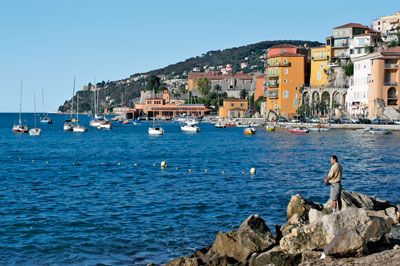Cap Ferrat
Beaulieu-sur-Mer
Villefranche-sur-Mer, France
Thursday, July 3rd
Villefranche is separated from Nice by Mont Boron. (An adventurous soul can hike to Nice over Mont Boron in about two hours, as I did six years ago.) It is a charming port town and seaside resort, with narrow streets winding their way up wooded coastal hills to the Moyene Corniche (N7) highway. There are some expensive homes in the hills, as well as many of more moderate means. And it is so very quiet. High above the town, you hear many birds and cicadas, but few cars. The year-round population is about 6,800 but the figure swells in the summer months as the tourists and seasonal residents pour in. But even with this influx, the little town remains calm and sedate. By five o'clock, everything shuts down, except for the restaurants in the port.
Artists were attracted by the colors and tranquility of the town. Jean Cocteau arrived in 1924 and lived here off and on throughout his life. In 1957, he decorated the façade and interior of Chapelle St-Pierre, a charming little chapel close to the Hotel Welcome. His theme is the life of St Peter, the patron saint of fishermen; and while some of the frescos are showing their age, the work remains fascinating.
Cap Ferrat is one the most prestigious peninsulas on the Côte d'Azur, its elegant homes hidden behind dense vegetation and high walls. Seven years ago we walked around Pointe St-Hospice on the eastern side. Today we decided to hike around the entire peninsula. The day was sunny and breezy, very comfortable.
We puzzled at the sight of five tiny sailboats being towed by a motorboat. It turned out to be sailing instruction, the man in the motorboat calling out for the sailors to perform different moves. Four did quite well but the fifth seemed so far out of it that the boat was eventually towed to shore and the unfortunate novice sent home.
We made a brief stop at the Brise Marine, a wonderful hotel we stayed at in 1996; and then on to Paloma Beach and the beginning of our trek.
The Mediterranean Sea is magnificent from this vantage point. Today was clear and sunny, with bright blue skies. The wind created whitecaps on the cobalt blue water. Actually, as we made our way around the Cap, the color of the sea would change, depending on wind and sun, but it was always some shade of blue. Last time we were here, the sky was gray and the winds much stronger. The surf crashed hard against the rocks below, spraying us and causing us to walk very carefully. Today's surf was calmer, but waves still washed up on the rocks below. I climbed down to the rocks and just sat for a while, watching and listening to the waves break. Many years ago, as a child at my grandparents cottage on Oberlin Beach, I would fall asleep to the sound of the loud surf pounding the southern shore of Lake Erie. Ever since, the roar of crashing surf has always put me in a peaceful state of mind.
We continued along the rocky southern shore and around Colombier Point. Here, the winds were blocked by the western point of the Cap and the surf became calm. After passing below the pine forest, we were briefly back among homes and automobiles. Avenue Claude Vignon took us past the little bay, Les Fosses, to the old quarry which provided rock to build the port of Monaco in the late 19th century.
The path past the quarry which ran out to the end of Cap Ferrat looked rather uninteresting, so we walked up to the residential area in hopes of seeing some of the expensive homes. Most were hidden behind high walls, sheltered from the prying eyes of tourists; but the tree-lined streets were quite beautiful. At the southern tip of Cap Ferrat is the Grand Hotel, one of the better known and most elegant hotels on the Côte d'Azur. We decided to stop, have a drink on the terrace, and soak up some ambiance. The long walk from the main entrance to the terrace was quite impressive, but when we got there it was empty. Noontime, but no customers, just a few waiters. Bummer. An elegant hotel with no customers lacks ambiance, or at least the kind we were seeking. We had heard that tourism was down but never expected this. We could only hope that the hotel's guests were sunning themselves at the private beach.
We set off again, passing the lighthouse that is visible from our room at the Hotel Welcome. It was built in 1951, replacing one destroyed at the end of World War II. The path along the western side of Cap Ferrat is rocky and rough, not paved as the previous one had been, and I soon developed blisters which would plague me off-and-on for the rest of the vacation. (My shoes were to blame; Al had no such problems.) The walk may have been tough on the feet, but it was a feast for the eyes. The terrain was rough, with rocky crevices and ravines below, smashed relentlessly by the sea. And thick trees blocked out all traces of the homes above us. To the west, we could see Villefranche and, further on, Nice. But on this trail, the predominant sense was one of solitude.
Our hike ended at Plage de Passable, a popular beach where we had a late lunch. Then the long walk back to Villefranche, the hotel, and a bottle of wine. Dinner that evening was at La Piazza, a so-so outdoor restaurant.
Photo Album
Along the Baie des Fourmis









